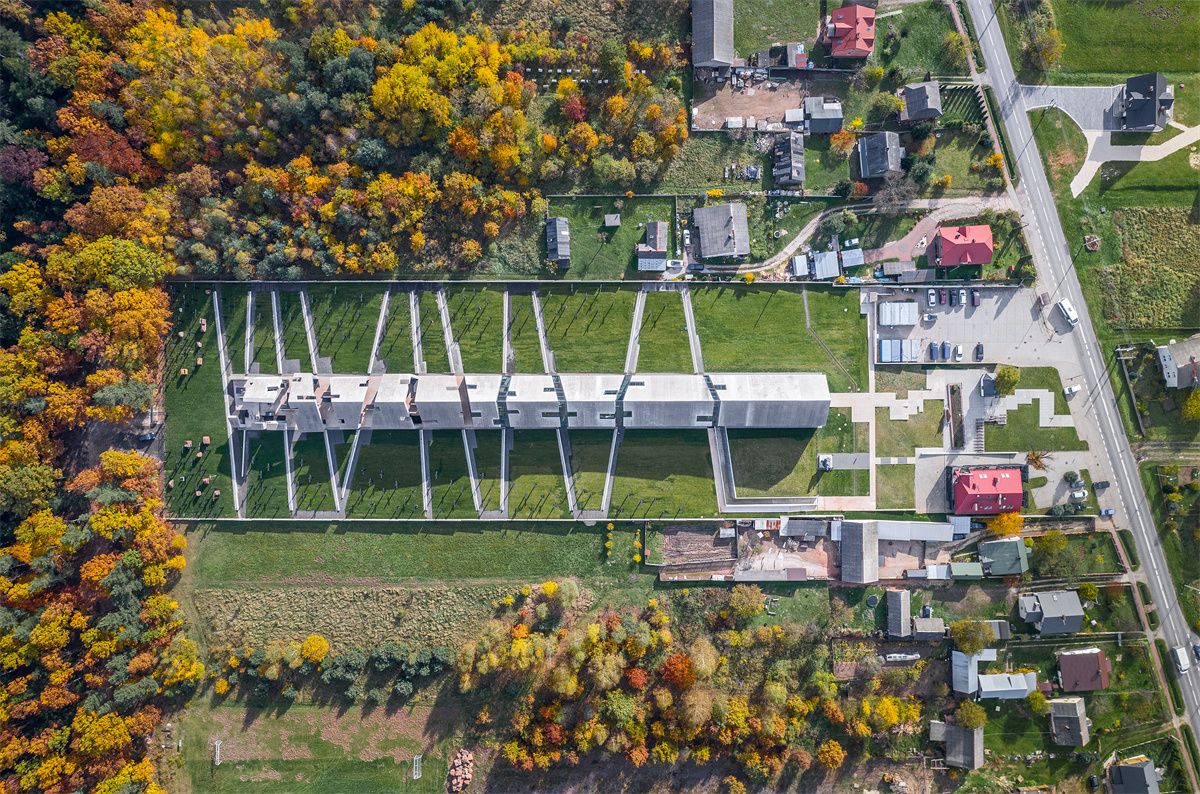
波兰村庄殉难者陵墓鸟瞰图 Aerial view of Mausoleum of Polish Rural Martyrology in Michniów © Marcin Czechowicz
从建筑的外观及南北立面看,波兰村庄殉难者陵墓令人联想到成排的乡村木屋。这排具有象征意义的小屋,外形上给人们带来不安感。建筑各分节段碰撞在一起又散落开来,仿佛经历了巨大的灾难、地震或火灾一样。这座陵墓雕塑实体是一座建筑纪念馆,由Nizio Design International建筑事务所设计;这是1943年二战期间德占波兰时Michniów和其他波兰村庄发生的绥靖行动的象征。在项目启动近 13 年后,于2021 年 7 月 12 日Michniów绥靖行动78 周年纪念日之际,即波兰村庄斗争和殉难日那一天,陵墓正式对外开放。
Viewed from the outside, from its northern and southern elevations, the building of the Mausoleum of Martyrdom of Polish Villages in Michniów brings to mind wooden country cottages arranged one behind the other. This row of symbolic huts has a disturbing form. Individual segments are crashed together and become disintegrated, as after a cataclysm, an earthquake or a fire. The sculptural solid of the Mausoleum, designed by Nizio Design International, is an architectural memorial; a symbol of the pacifications that took place in Michniów and other Polish villages in 1943, during World War II. After nearly 13 years since the project’s inception, on July 12th, 2021 the Mausoleum was officially opened on the 78th anniversary of the pacification of Michniów – on the Day of Struggle and Martyrdom of Polish Villages.
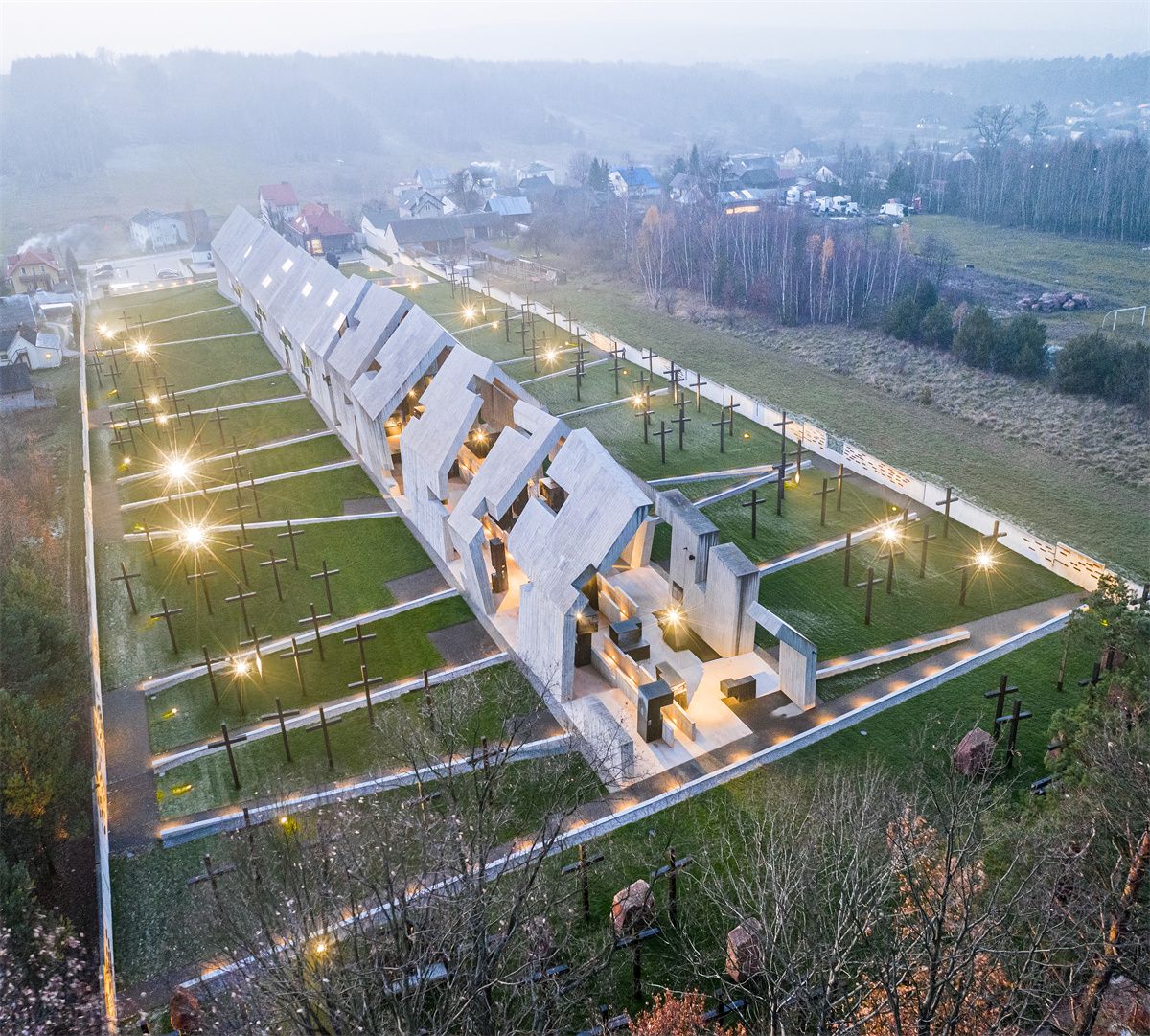
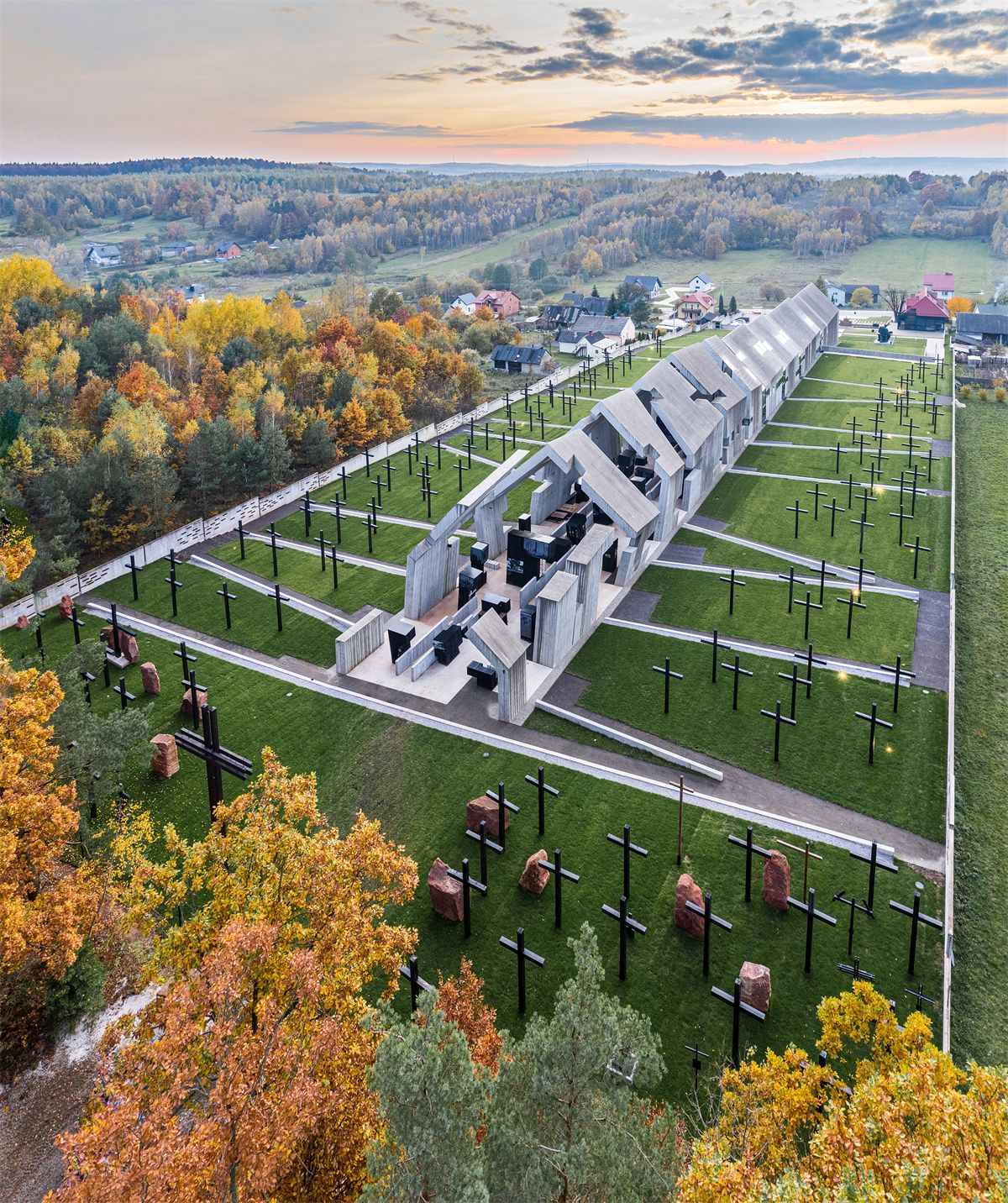
外观像一排木质乡村小屋 As if a row of wooden country cottages © Marcin Czechowicz
Michniów村庄里建造的“波兰村庄殉难者陵墓”是一种纪念建筑形式。这一实体反映了破坏与毁灭的过程,激发了Nizio Design International设计机构负责人Mirosław Nizio的灵感,创造了这种雕塑形式。陵墓的前景像一个乡村房屋。这座陵园首个完整的部分是“宁静之家”,随后的部分则传达出颠覆某种“世界秩序”过程的戏剧性:建筑实体被分解、破坏,仿佛经历了一场火灾。混凝土结构标有断裂、切割与撕裂,营造出种种情感和紧张氛围。陵墓的建筑和内部,以及永久性展览,都受到历史事件和绥靖行动重大影响的启发;它们体现了二战期间纳粹和苏联占领期间对波兰村庄进行镇压与控制。
The building of the Mausoleum of Martyrdom of Polish Villages in Michniów is an architectural form of commemoration. The solid reflects the process of destruction, annihilation, that inspired Mirosław Nizio, the head of Nizio Design International, to create this sculptural form. In the foreground, the Mausoleum resembles a rural house. This first, intact part of the building is the House of Tranquillity. Subsequent segments convey the dramaturgy of the process that has upset a certain “order of the world”: the solid is degraded, destroyed, as in the aftermath of a fire. The concrete structure is marked with fractures, cuts, tears which generate emotions and tension. Both the architecture and the interior of the Mausoleum, as well as the permanent exhibition, are strongly inspired by historical events and the dramatic effects of pacification; they are a symbol of the repression that affected Polish villages during World War II and the Nazi and Soviet occupations. 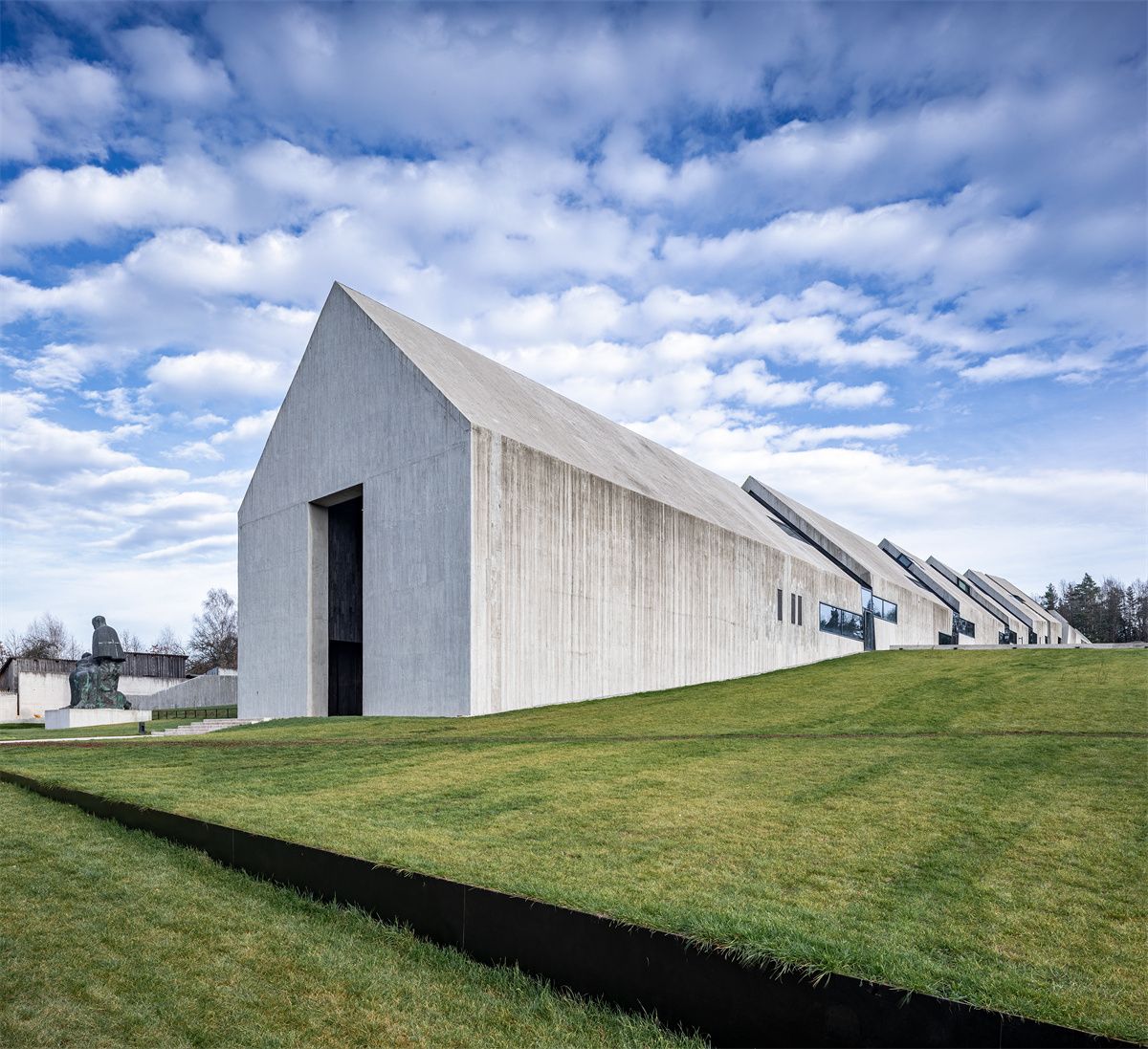
陵墓的前景像一个乡村房屋The Mausoleum resembles a rural house in the foreground. © Marcin Czechowicz
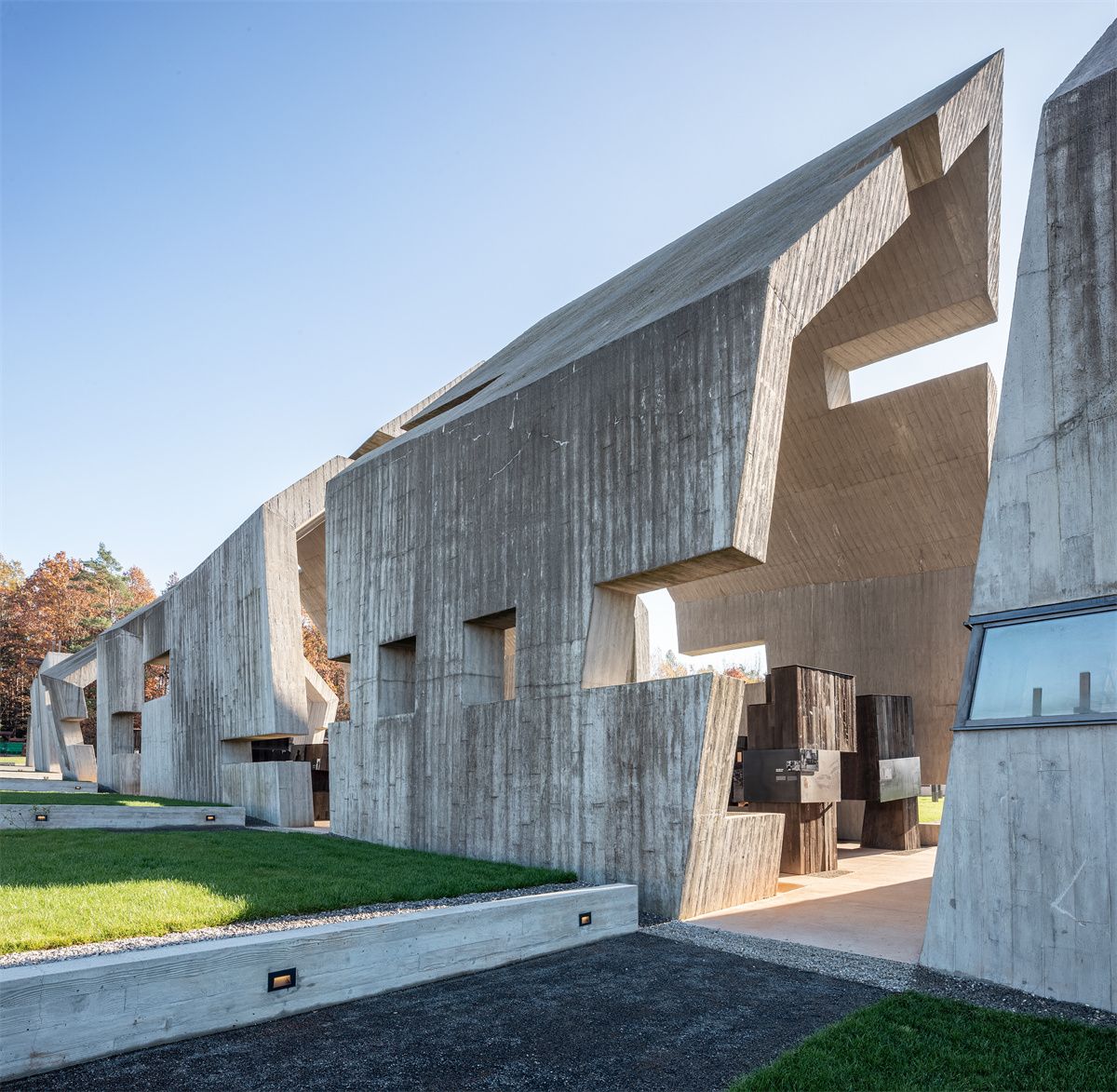
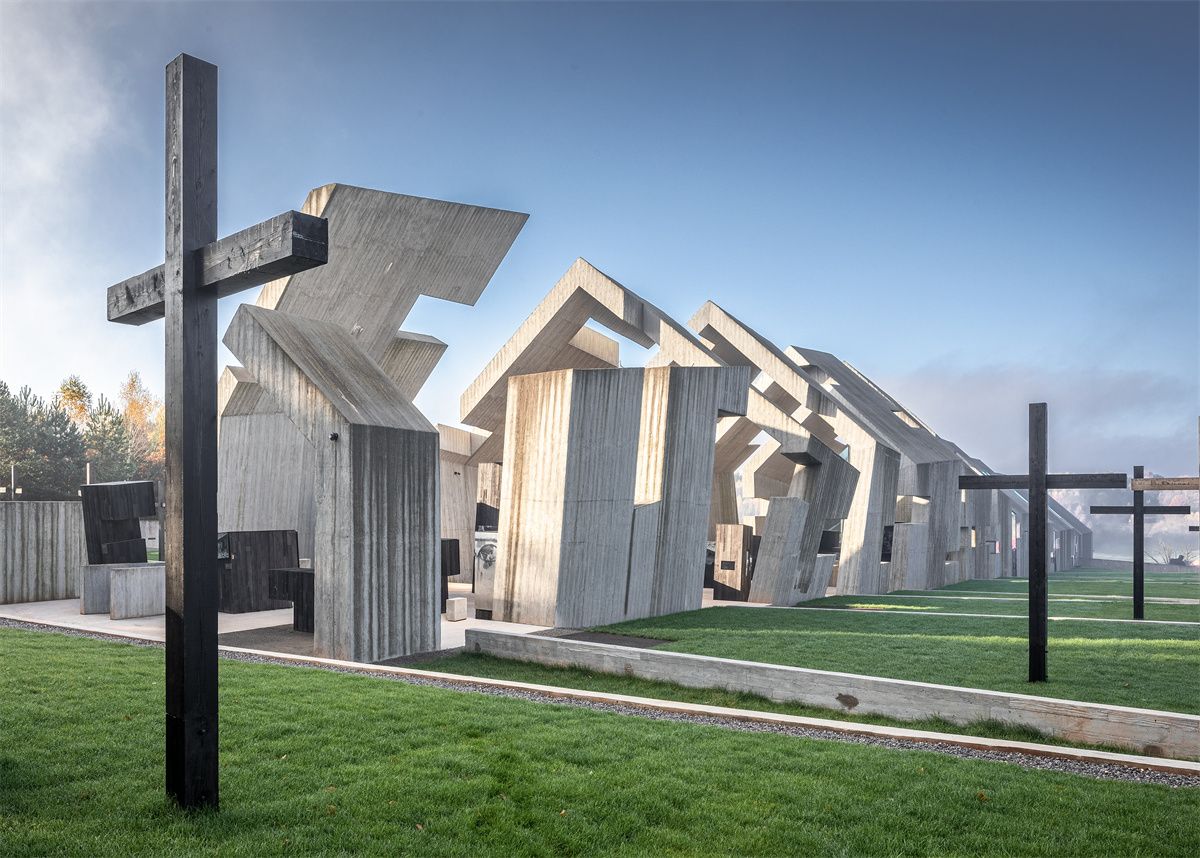
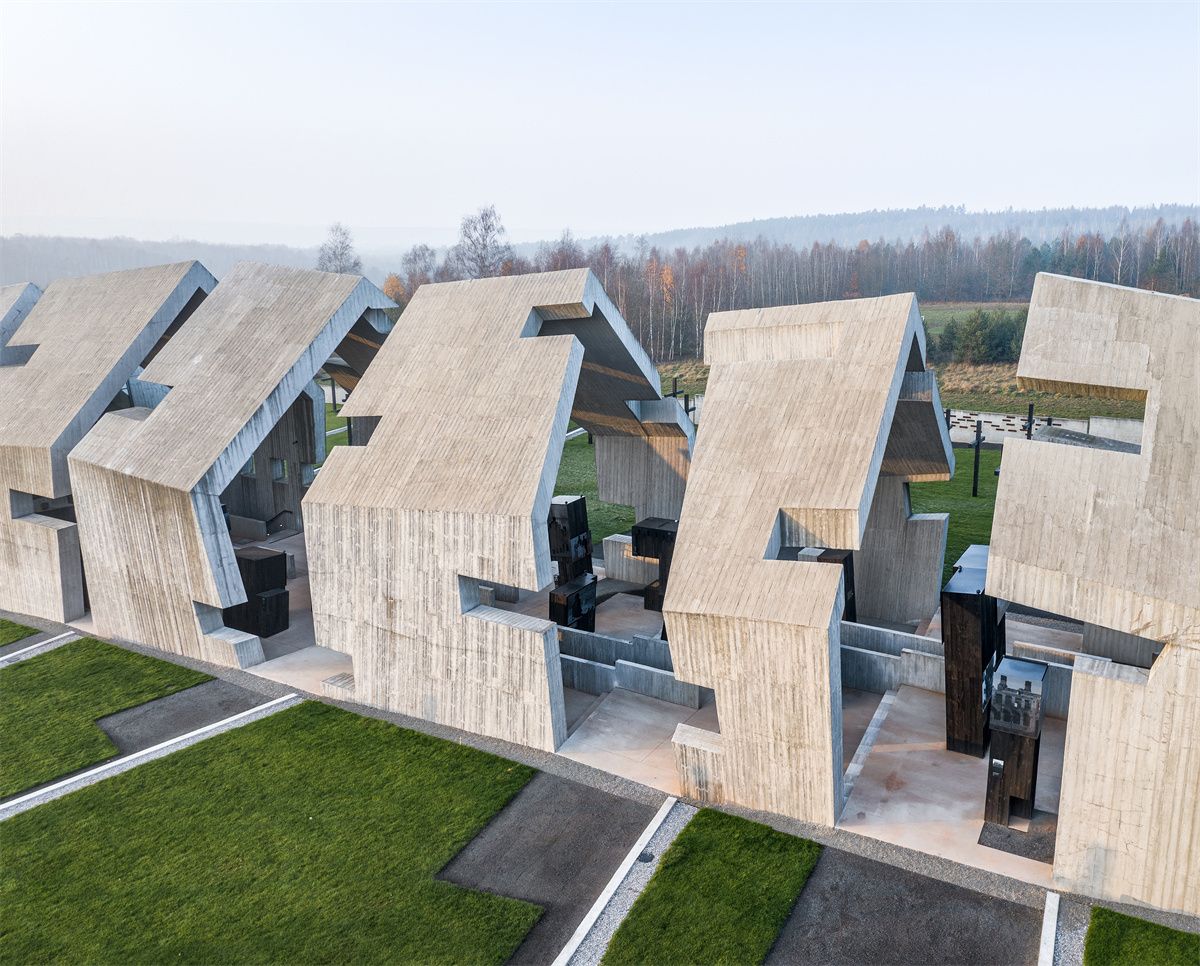 后半部分传递出分解、破坏感Subsequent segments convey the sense of degradation and destruction © Marcin Czechowicz
Michniów“波兰村庄殉难者陵墓”项目始于2009年。当时,Mirosław Nizio带领的团队在投资者组织的Kielce乡村博物馆竞赛中获得了一等奖。Mirosław Nizio回忆道,“看到Michniów这个村庄战前的历史照片,里面反映出的村庄里农舍、居民、日常生活场景,让人感到我们在与一些充实、完整且自然的生活节奏进行互动。反过来,当我们看到1943年绥靖行动的照片,看到人类戏剧、人员死亡、房屋燃烧,我们触碰到了那段痛苦的历史,体会到了伴随着生存被暴力破灭的情感。我们感受到了这种弥漫的、日益增长的破坏。这个过程给予了我们设计建筑外部和展览的动力。”
The project of the Mausoleum of Martyrdom of Polish Villages in Michniów was created in 2009. That was when the team led by Mirosław Nizio won the first prize in the competition organised by the investor – the Kielce Countryside Museum. “Viewing historical photographs of the pre-war village of Michniów with its cottages, its inhabitants, scenes from everyday life, we felt that we were interacting with something full, complete, with the natural rhythm of life. In turn, when looking at the photographs of the pacification of 1943, seeing human drama, death, burning houses, we touched upon painful history, experienced the emotions that accompany the violent breaking of the lifeline. We felt this pervasive and growing destruction. This process served as the impetus for the design of the exterior and the exhibition,” Mirosław Nizio recalls.
historical photographs on display相关历史照片展览 © Marcin Czechowicz
整个博物馆占地超过16000平方米,其形式是由雕塑灵感和建筑与历史叙事之间的统一想法决定。陵墓整体由11个部分组成——进入场地后,游客首先进入五个封闭的部分。雕塑般、分解的部分是开放的,可以接触自然、仰望天空并欣赏景观,随着天气的变化,有时会突然变化。通过玻璃和结构上的裂口,人们可以看到建筑周围落叶松交叉,它们的形状和象征意义赋予了裂口形式灵感。建筑极富有表现力,实体有意逐步分解退化,创造了一个独特的场地氛围。
The designed museum as a whole covers more than 16,000 m2. The form of the building was determined by sculptural inspirations and the wish for unity between the architecture that is being designed and the historical narration. The monolithic body of the Mausoleum consists of 11 segments – entering the premises, the visitor first enters five closed segments. The sculptural, degraded part is open to nature, sky and landscape, changing – sometimes abruptly – as the weather conditions change. Through the glazing and the rips in the structure one can see the larch crosses surrounding the building. Their shape and symbolism inspired the form of the rips. The expressive architecture and intentional, progressive degradation of the solid create a unique atmosphere of the place.
玻璃和结构上的开口裂缝 Glazing and the rips in the structure © Marcin Czechowicz
光线通过结构之间的裂缝照射到建筑内部;根据一天中不同的时间和季节,在建筑的封闭和开放部分,它模拟了永久展览的区域。建筑和透视细节的设计加强了感官体验。采用混凝土这一冰冷而理性的材料,其上的木质纹理象征性印记是显而易见的。混凝土会产生铜绿,时间的流逝和大自然的力量影响了它的质地和颜色。墙壁和屋顶结构以及钢构件上都留有水、灰尘和土壤的痕迹。这使得这一实体变得与周围环境更加交融,并深深扎根于当地的背景中去。
The light reaches the interior of the building through the cracks between the segments; depending on the time of the day and the season, it models the area of the permanent exhibition, located in the closed and open parts of the building. Architectural and scenographic details are designed to intensify the sensory experience. On concrete, the cool and ascetic material from which the solid is made, the symbolic imprint of the wood grain is noticeable. Concrete develops a patina. The passage of time and the forces of nature have influenced its texture and colour. The wall and roof structure and the steel components bear traces of water, dust and soil. This makes the solid become even more integrated with its surroundings and take root in the context of the place.
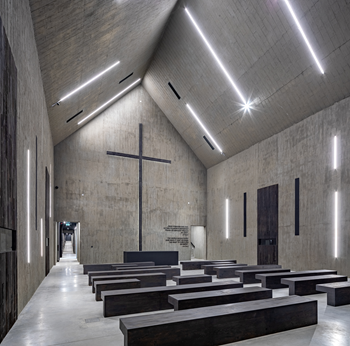 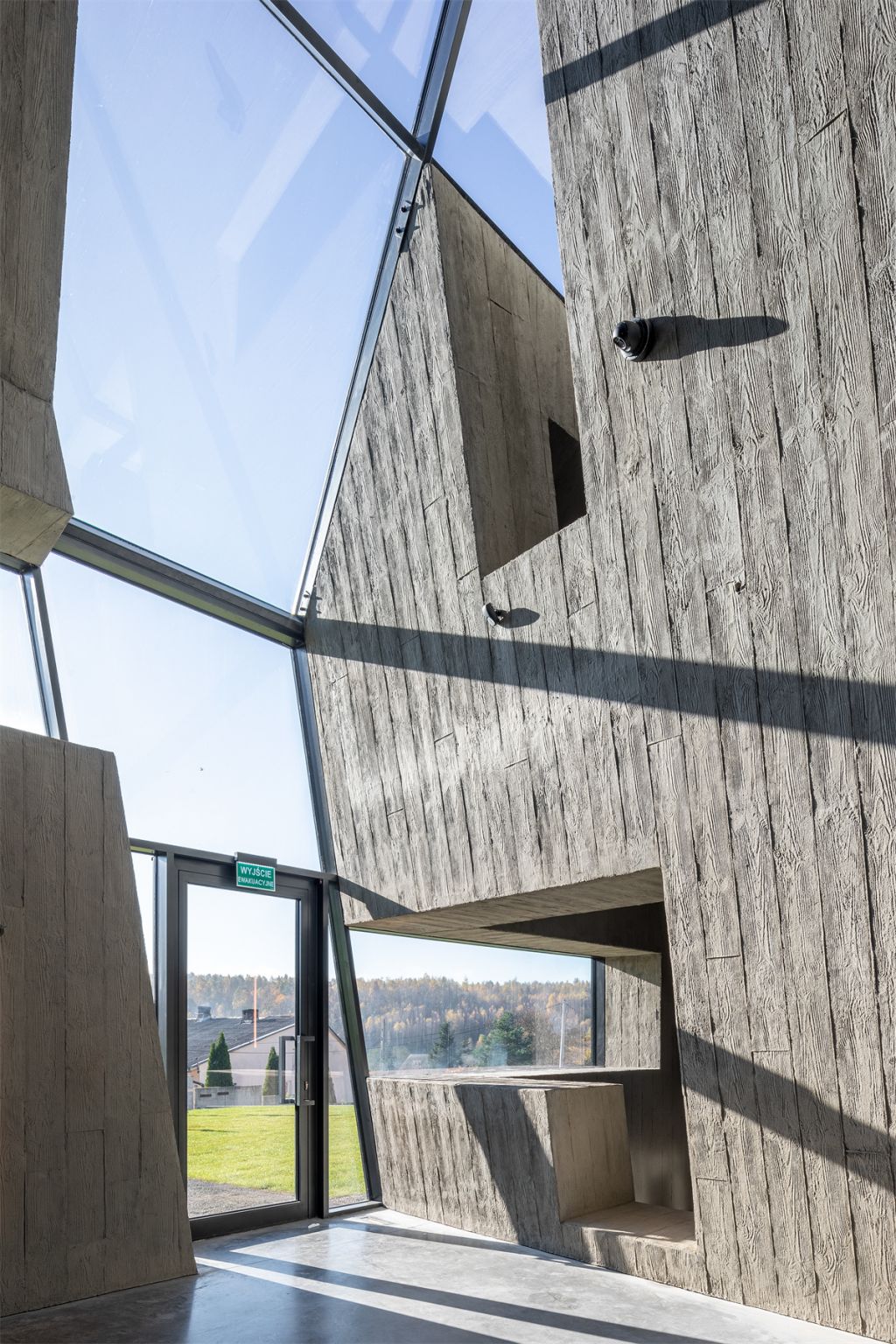 光线通过结构之间的裂缝到达建筑内部The light reaches the interior of the building through the cracks between the segments.© Marcin Czechowicz
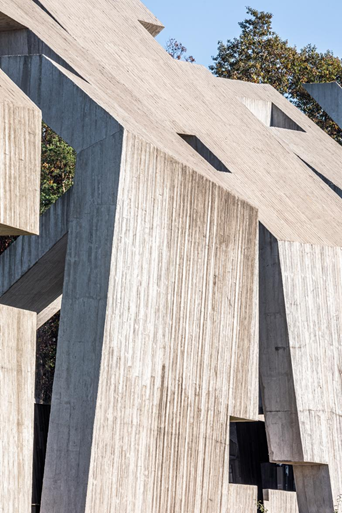
混凝土上的木纹印记 The wood grain imprint on concrete © Marcin Czechowicz
陵墓的永久展览面积约为1700平方米。讲述绥靖行动影响的叙述者,是受害者和执行命令的人。当参观者穿过建筑的各个部分时,他们面对的是烧焦的废墟。室内使用的主要材料是混凝土、从周围村庄运来的旧木屋和谷仓的木材及碳钢;它们便是展览叙述的媒介。展览中展示了照片和历史文件、多媒体素材。观众可以感觉到钢铁与发黑、烧焦的木材的气味,让人不安。所有这些因素都是为了影响参观者的感官。不规则形状的大型雕塑物体,类似于小屋的废墟,是博物馆展示内容的元素之一。其中一些被覆盖着黑色钢片,上面印记了绥靖行动的历史。
The permanent exhibition of the Mausoleum covers an area of about 1,700 m2. The narrators telling about the effects of pacification are the victims and the people responsible for the orders. As the visitors pass through successive parts of the building, they are faced with charred ruins. The materials that dominate in the interior are concrete, wood from the old huts and barns that was brought in from the surrounding villages, and black steel; they serve as a medium for the exhibition narrative. The displays present photos and historical documents, multimedia. The viewer can feel the disturbing smell of steel and blackened, scorched wood. All these factors are designed to affect the senses of the visitors. Large-sized sculptural objects of irregular shapes, resembling ruins of huts, are one of the elements of the museum content presentation. Some of them were covered with sheets of black steel with prints presenting the history of the pacification.
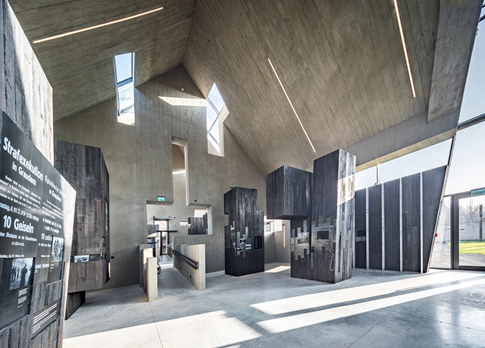 混凝土、旧木材和碳钢组成的展览空间 Exhibition space composed of concrete, old wood and black steel © Marcin Czechowicz
Nizio Design Internationl 同时设计了建筑和永久性展览,兼顾了这两种叙事的连贯性,是本项目的巨大价值所在,其在概念和建造阶段就已经得到了全世界的赞赏。2011年,该工作室获得了欧洲房地产奖公共服务建筑类别的荣誉。Dezeen.com是最具影响力的建筑和设计门户网站之一,将本项目列为2016年最值得期待的12座建筑之一。2021年6月,Mirosław Nizio在第10届POLITYKA Architectural Award建筑奖竞赛中凭借本项目设计获得了互联网用户奖。
The fact that Nizio Design International designed both the architecture and the permanent exhibition, taking care of the coherence of these two narratives, is a great value of the project, which has been appreciated all over the world already at the concept and construction stage. In 2011, the studio was honoured with the European Property Award in the Public Service Architecture category. Dezeen.com, one of the most influential portals about architecture and design, listed the Mausoleum as one of top 12 buildings to look forward to in 2016. In June 2021, Mirosław Nizio received the Internet Users’ Award for the design of the Mausoleum in the jubilee 10th edition of the POLITYKA Architectural Award competition.
建筑内部展览 Exhibition in the interior spaces © Marcin Czechowicz
Nizio Design International 国际建筑设计工作室是本陵墓的主要设计单位。由Mirosław Nizio领导的团队负责建筑、室内设计以及土地开发的概念、施工和实施阶段。该团队还监督项目从开始到完成的工作。工作室还负责监督项目的实施,Mirosław Nizio负责监督管理与永久性展览的场景和平面设计相关的活动。
Nizio Design International architectural studio is the chief designer of the Mausoleum. The team led by Mirosław Nizio was responsible for the design of the architecture and the interiors as well as for land development – in the concept, construction and implementation phases. The team also oversaw the work under the project from the beginning until the completion. The studio also provided the project author’s supervision over the implementation, and Mirosław Nizio oversaw the activities related to scenography and graphic design of the permanent exhibition.
手绘图:
项目构思阶段 © Nizio Design
内部结构构思 © Nizio Design
项目初步设计图 © Nizio Design
|
|
 - 手机版 - 小黑屋 - 园冶杯国际竞赛组委会
( 京ICP证090434 )
- 手机版 - 小黑屋 - 园冶杯国际竞赛组委会
( 京ICP证090434 )  - Design: Mobanbus
- Design: Mobanbus
 - 手机版 - 小黑屋 - 园冶杯国际竞赛组委会
( 京ICP证090434 )
- 手机版 - 小黑屋 - 园冶杯国际竞赛组委会
( 京ICP证090434 )  - Design: Mobanbus
- Design: Mobanbus